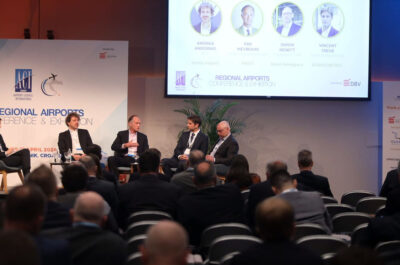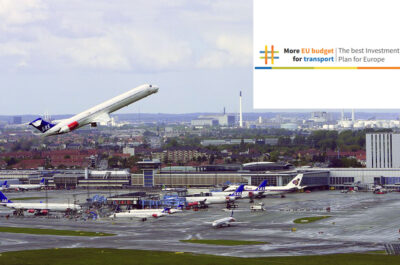The issue of State Aid is a difficult one, in this context. It is essentially a balancing act between limiting distortion of competition and market developments – the EC fully recognises that airports compete – versus the need to safeguard economic activity and social inclusion by ensuring regional infrastructure remains intact.
BRUSSELS – Following a 2 year review process, the European Commission (EC) released its new State Aid Guidelines for the aviation sector, which will shape the public funding of EU airports in the years ahead. European airport trade body ACI Europe, together with the Assembly of European Regions (AER) generally welcomed the fresh clarity that these Guidelines should deliver, but also expressed concern about their medium-term impact on regional airports and connectivity.
Today, European airports are operating in a highly competitive market, yet smaller airports are structurally unable to sustain themselves. This is due to a combination of high fixed costs, limited access to non-aeronautical (commercial) revenues and lower yields compared to larger airports. As a result, clearer rules have long been needed to allow these airports to receive support where really necessary – particularly given it was widely acknowledged that the preceding Guidelines could not be enforced effectively.
The issue of State Aid is a difficult one, in this context. It is essentially a balancing act between limiting distortion of competition and market developments – the EC fully recognises that airports compete – versus the need to safeguard economic activity and social inclusion by ensuring regional infrastructure remains intact. The unparalleled connectivity that an airport can bring plays such an instrumental role in attracting and retaining economic growth – it cannot be omitted from the EU’s growth and jobs strategy.
Olivier Jankovec, Director General, ACI Europe commented “European airports compete tooth & nail to retain and attract air services and these much awaited new Guidelines provide a level-playing field upon which to do so. As well as serving the industry, these Guidelines should be implemented in a way that better secures the many economic and social benefits associated with air access in the EU. Hopefully, they will also bring an end to the squabbling between the different types of airlines, as the real world parameters of these new rules become clearer in the months ahead.”
Operating Aid… & 2019
The most contentious aspect was the EC’s initial intention to curb operating aid for all airports with more than 200,000 passengers per annum (ppa) after a 10 year transitional period. This has been reconsidered and the Guidelines now provide for a special regime for airports with up to 700,000 ppa.
However, the EC has fallen short of providing the long-term legal certainty needed for these airports and their communities – as it intends to reassess this stop-gap measure in 5 years’ time. Operating aid for smaller airports remains the most consequential element of the Guidelines, with grave repercussions for regional economies, if the wrong choices are made.
Jankovec and Jan Owe-Larsson, President East Sweden Region (SE), Chairman of the AER Working Group on Transport and Regional Airports added “Over the past 2 years, the Commission’s initial proposal has evolved and the new Guidelines it has released today better reflect the economic realities of operating a small airport. They also recognise – at least for the time being – that closing down these airports would damage connectivity and kill regional communities not only in remote & peripheral regions, but across Europe.”
They also cautioned “That said, those structural & financial challenges that regional airports face today are still going to be with us in 2019 and if anything, will have intensified. We already know that regulatory-induced costs are going to increase for airports, while newly permitted levels of operating aid will stand at just 80% of current operating funding gaps. When decision-time comes around again, we will simply not be in a position to get this wrong.”
Investment Aid
On funding for airport development & modernisation projects, the right balance has been achieved and both ACI Europe and AER expressed their support for the EC approach based on decreasing aid intensity, as air traffic grows.
Moreover, further improvements of initial EC proposals means that airports should be better placed to meet the needs of the travelling public in the years ahead. Airports with 3-5 million ppa now have greater investment opportunities than the originally-proposed Guidelines allowed. And the possibility now remains for some public support for very large greenfield airport projects – a crucial change if Europe is to remain a player in the global race for air connectivity. Aviation is not limited to European borders and in every other continent, airport infrastructure can and frequently does receive considerable public financing. This is part of national economic strategies aimed at boosting connectivity – and indirectly supporting airlines.
Jankovec added “The new framework on investment aid is of major significance and here the Commission has clearly taken note of the unique value airports bring to society. As EUROCONTROL has repeatedly warned, Europe is facing a looming airport capacity crunch with 12% of demand for air transport expected to be unaccommodated in 2035. In order for Europe to stay globally relevant, we should be able to address airport investment as flexibly as our peers in other world regions.”
Start up Aid
There has been significant media interest in the proposals concerning aid by regional airports and/or local public authorities to incentivise airlines to start up new routes.
On this, Jankovec commented “We like the thought and focus which the Guidelines give to the regulation of start up aid to airlines. However, the implementation and enforcement of these new rules will ultimately determine whether clarity and simplicity have been achieved. With this in mind, we eagerly await the precedents set by forthcoming decisions on individual cases.”
Intermodal Competition
It is worth noting that other sectors within Transport, such as rail in particular, do not have to operate under such restrictive rules on public financing. In the wider scheme of things, this puts aviation at a competitive disadvantage, while allowing the rail sector over 30 billion euros in public funding each year.
Theodore is the Co-Founder and Managing Editor of TravelDailyNews Media Network; his responsibilities include business development and planning for TravelDailyNews long-term opportunities.































































































































































































